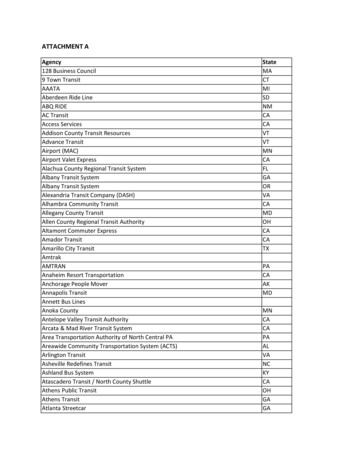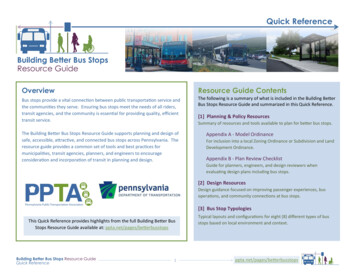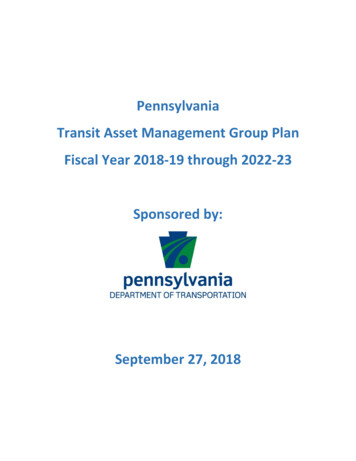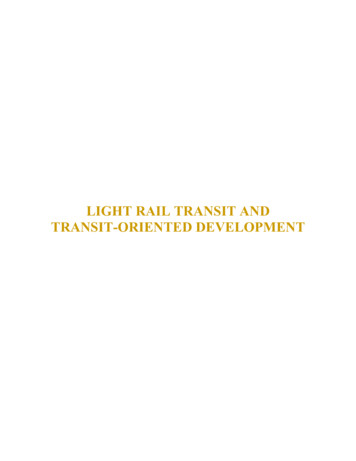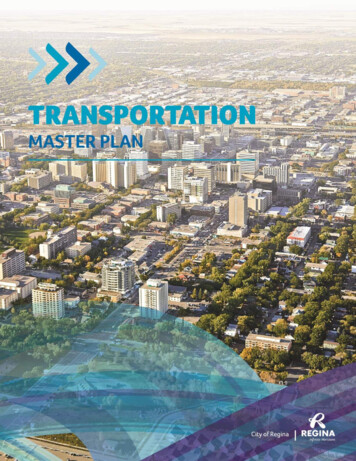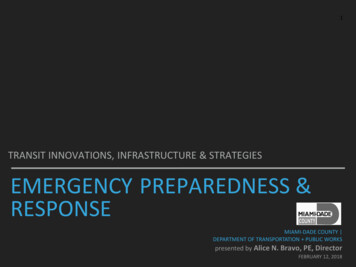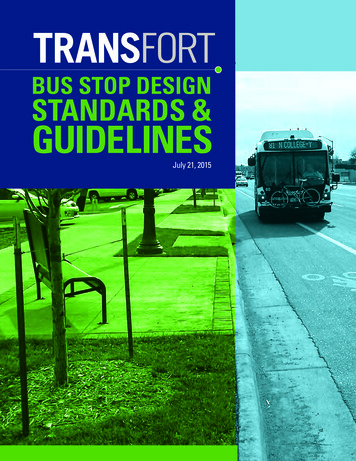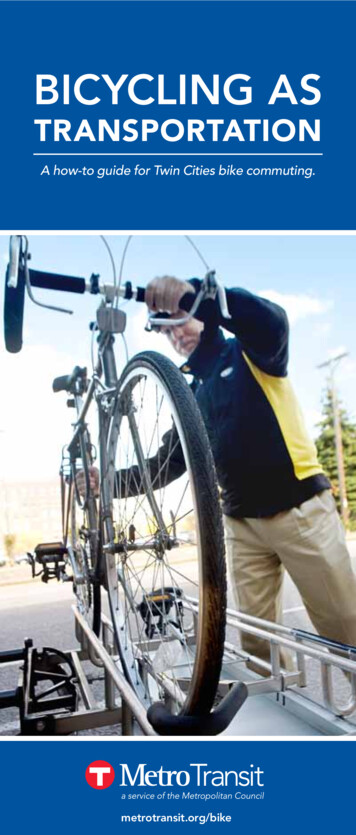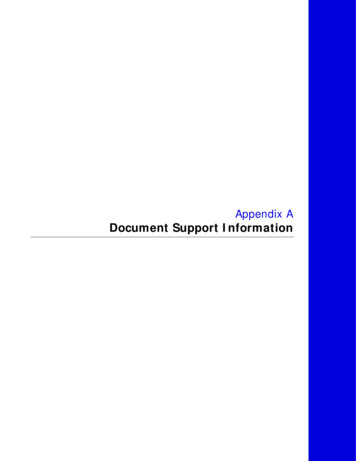
Transcription
New Jersey Transit CorporationTitle VI Compliance ReviewFinal ReportSeptember 2017
Title VI Compliance Review Draft Report: NJ TransitThis page intentionally left blank to facilitate duplex printing.September 2017
Title VI Compliance Review Draft Report: NJ TransitSeptember 2017Table of ContentsExecutive Summary . 11. General Information . 32. Jurisdiction and Authorities . 53. Purpose and Objectives . 73.13.2Purpose . 7Objectives . 74. Introduction to the New Jersey Transit Corporation . 94.1NJ Transit Description and Organizational Structure . 95. Scope and Methodology . 135.15.2Scope . 13Methodology . 136. Findings of the General Reporting Requirements and Guidelines . 176.16.26.36.46.56.66.76.86.96.106.11Inclusive Public Participation. 17Language Access to LEP Persons . 18Title VI Complaint Procedures . 21Record of Title VI Investigations, Complaints, and Lawsuits . 23Notice to Beneficiaries of Protection under Title VI. 23Annual Title VI Certification and Assurance. 24Providing Assistance to Subrecipients . 25Monitoring Subrecipients . 25Minority Representation on Planning or Advisory Bodies . 26Determination of Site or Location of Facilities . 27Submit Title VI Program . 277. Findings of the Program-Specific Requirements for Large Fixed-Route Transit Providers . 297.17.27.37.4Demographic Data. 29System-wide Service Standards and Policies . 31Evaluation of Service and Fare Changes. 34Monitoring Transit Service . 388. Findings of the Program-Specific Requirements for States . 418.18.2Statewide Planning Activities . 41Program Administration . 42
Title VI Compliance Review Draft Report: NJ TransitSeptember 20179. Summary of Findings and Corrective Actions . 4510. Compliance Review Attendee List . 51Attachment A – FTA Notification Letter to NJ Transit . 53Attachment B – NJ Transit Response . 59
Title VI Compliance Review Draft Report: NJ TransitThis page intentionally left blank to facilitate duplex printing.September 2017
Title VI Compliance Review Report: NJ TransitSeptember 2017Executive SummaryObjective and Methodology – This report details the findings of a Compliance Review of theNew Jersey Transit Corporation’s (NJ Transit) Title VI program implementation. TheCompliance Review examined this agency’s Title VI program procedures, managementstructures, actions, and documentation. The review team collected documents and informationfrom the Federal Transit Administration (FTA) and NJ Transit. In addition, the review teaminterviewed the following entities as part of this review: National Association for theAdvancement of Colored People (NAACP) New Jersey, Urban League of Hudson City, andSocial Community Activities Network. The review team also visited one FTA Section 5310subrecipient, JFK Adult Medical Program, and one FTA Section 5311 subrecipient, SpecialCitizen Area Transportation (SCAT) operated by the Monmouth County Division ofTransportation. The three-day review included interviews, assessments of data collectionsystems, and review of program documents.NJ Transit’s Title VI Program includes the following positive program elements – Positive Program ElementsMonitoring Subrecipients – NJ Transit did an excellent job monitoring its FTA Section5310 and 5311 subrecipients for Title VI compliance.Providing Assistance to Subrecipients - NJ Transit did an excellent job providingassistance to subrecipients on the development and implementation of their Title VI plans.Evaluation of Service and Fare Changes – NJ Transit’s procedures for evaluating serviceand fare changes met FTA requirements.Statewide Planning Activities – NJ Transit conducted statewide planning activities for itsFTA Section 5310 and FTA Section 5311 programs, as required.Program Administration - NJ Transit’s procedures for administering FTA Section 5310 andFTA Section 5311 program funds met FTA requirements.The Program has the following substantive deficiencies –Substantive Deficiencies Requirement to Provide Meaningful Access to LEP Persons – NJ Transit’s LEP FourFactor Analysis did not sufficiently address FTA Circular 4702.1B, Chap. III-6, Part 9requirements, and NJ Transit did not develop a Language Assistance Plan based on theresults of its LEP Four-Factor Analysis. Title VI Notice to Beneficiaries – NJ Transit did not translate hard copies of its Notice inlanguages other than Spanish and Portuguese. Demographic Data - NJ Transit’s demographic profile maps did not show minorityconcentrations in the aggregate or by race, as required by FTA Circular 4702.1B, Chap. IV7, Part 5. System-wide Service Standards and Policies - NJ Transit’s service policy for thedistribution of transit amenities was lacking. Monitoring Transit Service - NJ Transit did not define its minority routes per FTA Circular4702.1B, Chap. IV-9, Part 6 guidance.1
Title VI Compliance Review Draft Report: NJ TransitSeptember 2017This page intentionally left blank to facilitate duplex printing2
Title VI Compliance Review Draft Report: NJ TransitSeptember 20171. General InformationThis chapter provides basic information concerning this compliance review of the New JerseyTransit Corporation (NJ Transit). Information on NJ Transit, the review team, and the dates ofthe review are as follows:Grant Recipient:New Jersey Transit CorporationCity/State:Newark, NJGrantee Number:1414Executive Official:Steven H. Santoro, Executive DirectorOn-site Liaison:Leotis Sanders, VP Office of Civil Rights andDiversity ProgramsReport Prepared By:The DMP Group, LLCDates of On-site Visit:May 9–12, 2017Compliance Review TeamMembers:John Potts, Lead ReviewerDonald Lucas, ReviewerKhalique Davis, ReviewerDanielle Slattery, Reviewer3
Title VI Compliance Review Draft Report: NJ TransitSeptember 2017This page intentionally left blank to facilitate duplex printing4
Title VI Compliance Review Draft Report: NJ TransitSeptember 20172. Jurisdiction and AuthoritiesThe Secretary of Transportation authorized the Federal Transit Administration (FTA) Office ofCivil Rights to conduct civil rights compliance reviews. NJ Transit is a recipient of FTA fundingassistance and is therefore subject to the Title VI compliance conditions associated with the useof these funds pursuant to the following: Title VI of the Civil Rights Act of 1964 (42 U.S.C. Section 2000d) Federal Transit Laws, as amended (49 U.S.C. Chapter 53 et seq.) Uniform Relocation Assistance and Real Property Acquisition Policies Act of 1970, asamended (42 U.S.C. 4601 et seq.) Department of Justice regulation, 28 CFR Part 42, Subpart F, “Coordination ofEnforcement of Nondiscrimination in Federally-Assisted Programs” (December 1, 1976,unless otherwise noted) U.S. Department of Transportation (DOT) regulation, 49 CFR Part 21,“Nondiscrimination in Federally-Assisted Programs of the Department ofTransportation—Effectuation of Title VI of the Civil Rights Act of 1964” FTA Circular 4702.1B “Title VI Requirements and Guidelines for Federal TransitAdministration Recipients” FTA Circular 4703.1 “Environmental Justice Policy Guidance for Federal TransitAdministration Recipients” DOT Policy Guidance Concerning Recipients’ Responsibilities to Limited EnglishProficient Persons (December 14, 2005) Executive Order 13166: “Improving Access to Services for Persons with Limited EnglishProficiency” Section 13 of FTA’s Master Agreement 22 (October 1, 2016)5
Title VI Compliance Review Draft Report: NJ TransitSeptember 2017This page intentionally left blank to facilitate duplex printing.6
Title VI Compliance Review Draft Report: NJ TransitSeptember 20173. Purpose and Objectives3.1PurposeThe Federal Transit Administration (FTA) Office of Civil Rights periodically conductsdiscretionary reviews of grant recipients and subrecipients to determine whether they arehonoring their commitments, as represented by certification, to comply with the requirements of49 U.S.C. 5332. In keeping with its regulations and guidelines, FTA determined that acompliance review of NJ Transit’s Title VI Program was necessary.The Office of Civil Rights authorized The DMP Group, LLC, to conduct the Title VI compliancereview of NJ Transit. The primary purpose of this compliance review was to determine theextent to which NJ Transit has met its General Reporting and Program-Specific Requirementsand Guidelines, in accordance with FTA Circular 4702.1B, “Title VI Requirements andGuidelines for Federal Transit Administration Recipients.” Members of the review team alsodiscussed with NJ Transit the requirements of the DOT “Guidance on Special LanguageServices to Limited English Proficient (LEP) Beneficiaries” contained in Circular 4702.1B. Thecompliance review had a further purpose to provide technical assistance and to makerecommendations regarding corrective actions, as deemed necessary and appropriate. Thecompliance review was not an investigation to determine the merit of any specific discriminationcomplaints filed against NJ Transit.3.2ObjectivesThe objectives of FTA’s Title VI Program, as set forth in FTA Circular 4702.1B, dated October 1,2012, “Title VI Requirements and Guidelines for Federal Transit Administration Recipients” areto: Ensure that the level and quality of public transportation service is provided in anondiscriminatory manner; Promote full and fair participation in public transportation decision-making without regardto race, color, or national origin; Ensure meaningful access to transit-related programs and activities by persons withlimited English proficiency.7
Title VI Compliance Review Draft Report: NJ TransitSeptember 2017This page intentionally left blank to facilitate duplex printing.8
Title VI Compliance Review Draft Report: NJ TransitSeptember 20174. Introduction to the New Jersey Transit CorporationNJ Transit is New Jersey’s statewide public transportation corporation, serving over 8.7 millionresidents over a 5,325-square mile service area. In FY 2016, NJ Transit provided 277 millionpassenger trips and operated 3.5 billion passenger miles on its multi-modal transit system thatincluded bus, light rail, and commuter rail service. In addition to operating one of the nation’sfive largest transit systems, NJ Transit is responsible for administering FTA Section 5310 andSection 5311 formula funds for the State of New Jersey. NJ Transit’s responsibilities includeawarding Section 5310 and Section 5311 funds to subrecipients throughout the State,monitoring subrecipient compliance with FTA Title VI requirements, and providing assistance tosubrecipients to help them comply.4.1NJ Transit Description and Organizational StructureThe New Jersey Public Transportation Act of 1979 established NJ Transit in the executivebranch of the state government. The Act constituted NJ Transit as an instrumentality of the stateexercising public and essential governmental functions and deemed the powers exercised byNJ Transit as an essential state governmental function. The Act placed NJ Transit within theNew Jersey Department of Transportation but stated that the corporation should operateindependently from the department. The governor designated NJ Transit as the recipient forFTA funds, established to "acquire, operate and contract for transportation service in the publicinterest."A nine-member Board of Directors governs NJ Transit. The Board of Directors is comprised ofthe Governor and eight members appointed by the Governor: the NJ Transit Executive Director,Commissioner of the Department of Transportation, Governor’s representative, Acting StateTreasurer, and four members from the public. The Commissioner of the Department ofTransportation serves as the Board Chair.NJ Transit’s bylaws give the Executive Director, who answers to the Board, the requisiteauthority to act on behalf of the Board of Directors. Annually, the Board of Directors authorizesthe Executive Director to apply for FTA funds.Several transit advisory committees provide the agency with input from the public. Theseadvisory committees include the North Jersey Transit Advisory Committee (NJTAC), SouthJersey Transit Advisory Committee (SJTAC), and the Senior Citizen Disabled ResidentTransportation Advisory Committee (SCDRTAC). NJTAC and SJTAC are comprised of 14unsalaried members, each appointed by the Governor with the support of State Senators.Members of NJTAC served four-year terms, and members of SJTAC served three-year terms.SCDRTAC had 13 members who served three-year terms.NJ Transit provides commuter rail, light rail, fixed-route bus, and Americans with Disabilities Act(ADA) complementary paratransit service and administers community mobility programs.Commuter Rail - NJ Transit operates a fleet of 711 trains on a commuter rail network of 11 linesthat served 166 stations in 137 communities. Seven of the 11 lines provide service to New York.9
Title VI Compliance Review Draft Report: NJ TransitSeptember 2017One line, the Atlantic City Line, serves Philadelphia’s 30th Street Station. NJ Transit maintainsits fleet of over 170 diesel and electric locomotives and over 1,100 rail cars at the MeadowsMaintenance Complex located near Newark. NJ Transit performs light maintenance at the endof the lines. In addition to operating its own service, NJ Transit provides contracted commuterrail service to the New York Metropolitan Transit Authority from Hoboken Terminal to Port Jervisin New York State on the Main/Bergen County Line.Light Rail - NJ Transit’s three light rail networks, Newark Light Rail, Hudson-Bergen Light Rail,and River LINE, use a fleet of 93 light rail vehicles. The 6.5-mile Newark Light Rail has two linesthat serve 17 stations. Both lines serve downtown Newark and terminate at Newark’s PennStation. The 20-mile Hudson-Bergen Light Rail, which links the growing cities of the HudsonWaterfront, has three lines serving 23 stations. The 34-mile River LINE, which operatesbetween Trenton and Camden, has 20 stations. NJ Transit directly operates the Newark LightRail and contractors operate the Hudson-Bergen Light Rail and River LINE.Fixed-Route Bus - NJ Transit, through direct service, private carrier support, and contracted busservice, provides an extensive network of intrastate and interstate bus service. Each year, thefleet of 3,172 buses travels over 164 million miles on 264 routes. The network serves theregion’s commercial centers with commuter runs to and from Manhattan, Newark, Jersey City,Trenton, Camden, Atlantic City, and Philadelphia. NJ Transit operates out of 15 garages andcontracts with 12 private contractors.ADA Complementary Paratransit Service - NJ Transit contracts for the provision of Access Link,its curb-to-curb ADA complementary paratransit service. The State is divided into six regionswith an Access Link contractor assigned to each one. NJ Transit determines eligibility andoperates the trip reservation center.Private Carriers - NJ Transit administers programs to provide buses and bus-related equipmentto private carriers, as follows: Bus Allocation Program. NJ Transit leases 751 buses to 30 private carriers at no cost.The carriers provide interstate service under authority provided by the Federal SurfaceTransportation Board and intrastate service under authority provided by the New JerseyDOT. NJ Transit uses FTA (Sections 5307 and 5309) and State funds to purchase thebuses. The buses display the carrier’s logo and a statement that NJ Transit owns thebuses. Carriers that participate in the program filed separate National Transit Databasereports. Private Carrier Capital Improvement Program. NJ Transit leases support equipment,such as radios, fare boxes, computers, portable lifts, support vehicles, fuel managementsystems, and bus washers, at no cost to private carriers. Only carriers that lease buseswere eligible for the program. This program does not involve any FTA funding. Reduced Fare Reimbursement Program. NJ Transit reimbursed carriers that providedreduced fares to elderly persons, persons with disabilities, and students.Community Mobility - NJ Transit passes FTA funds (Sections 5307, 5309, 5310, 5311, 5316,and 5317) and Congestion Mitigation Air Quality (CMAQ) funds to subrecipients to support a10
Title VI Compliance Review Draft Report: NJ TransitSeptember 2017range of public transportation and mobility programs that include demand response anddeviated fixed-route public transportation, transportation for elderly persons and persons withdisabilities, feeder service to commuter rail stations, and access to jobs for low-income persons.Over the next three to five years, NJ Transit plans to implement the following noteworthyprojects: Raritan River Drawbridge Replacement – This project involves the completereplacement of the Raritan River Bridge, which spans the Raritan River between PerthAmboy and South Amboy, with a bridge that will be used for daily passenger and freightrail service on NJ Transit’s North Jersey Coast Line. The project includes civil and trackwork on the approaches to the new bridge and the removal of the existing bridge. To theextent feasible, NJ Transit will design and build the new movable bridge to betterwithstand ocean surge and lateral forces due to wave action with critical machinery andcontrols for the bridge above the Federal Emergency Management Agency’s base floodelevation. Lackawanna Cut-Off Project – This project involves the conceptual planning andengineering work associated with the restoration of passenger rail along the NorthwestNew Jersey and Southeast Pennsylvania corridor by using existing and abandoned railright-of-way between Port Morris, New Jersey, and Scranton, Pennsylvania. NJ Transitis considering constructing stations at Scranton, Tobyhanna, Mount Pocono, Anal mink,East Stroudsburg, and Delaware Water Gap in Pennsylvania and at Blairstown andAndover in New Jersey. NJ Transit is planning to construct a yard site in Scranton. Theproject consists of a single-track commuter rail line with passing sidings betweenScranton and Port Morris, where it will connect with NJ Transit's Montclair andBoonton/Morristown Lines. The 60 miles in Pennsylvania are currently used for freightservice. The 28-mile stretch from the Delaware River Bridge to Port Morris, over theLackawanna Cut-Off, is currently abandoned. Train service will operate over the 45miles from Port Morris to Hoboken and serve New Jersey stations.Another ongoing initiative included the 8th Street Station Project in Bayonne, a 1-mile southernextension of Hudson-Bergen Light Rail. NJ Transit is advancing the civil engineering portion ofthe project with a design/build contractor and the systems work with the current operator ofHudson-Bergen Light Rail. Concept planning for the project began in December 2005.NJ Transit’s service area consists of the State of New Jersey, which is divided into 21 countiesand further divided into 566 municipalities, including 52 cities, 250 boroughs, 15 towns, 246townships, and three villages. The State covers approximately 7,417 square miles and had a2000 population of 8,414,350. The population increased by 2010 to 8,791,894. The followingtable represents a demographic profile of the State. The table shows the 2000 and 2010population by racial/ethnic group, the increase (or decrease) in population from 2000 to 2010,and the percentage of the racial/ethnic group population relative to the total population in both2000 and 2010. The table also shows the 2000 and 2010 population of individuals below thepoverty level (low-income) and individuals who speak English less than “very well” (limitedEnglish).11
Title VI Compliance Review Draft Report: NJ TransitSeptember 2017State of New JerseyRacial/ Ethnic GroupWhiteBlackAmerican Indian and AlaskaNativeAsianNumberPercent2000 U.S. Census6,104,70572.61,141,82113.6NumberPercent2010 U.S. 480,2765.7725,7268.33,3290.0Other RaceTwo or MoreHispanic Origin 1450,972213,7551,117,1915.42.513.3Total .5%Hawaiian/Pacific IslanderLimited English rce: American Community Survey 2015 data (total population estimate 8,944,469).From 2000 to 2010, NJ Transit’s service area population increased 4.5 percent. The Whitepopulation deceased 1.2 percent, the Black population increased 5.5 percent, the Hispanicpopulation increased 39 percent, the Asian population increased 51 percent, the AmericanIndian/Alaskan Native population increased 49 percent, and the Hawaiian/Pacific Islanderpopulation decreased 8.6 percent. In 2010, 68.6 percent of the total population was White, 13.7percent was Black, 17.7 percent was Hispanic, 8.3 percent was Asian, 0.3 percent wasAmerican Indian/Alaskan Native, and Hawaiian/Pacific Islanders represented less than 0.1percent.1Per the 2000 Census, people of Hispanic origin can be, and in most cases are, counted in two or more racecategories.12
Title VI Compliance Review Draft Report: NJ TransitSeptember 20175. Scope and Methodology5.1ScopeThe Title VI compliance review of NJ Transit examined the following requirements andguidelines as specified in FTA Circular 4702.1B:General Reporting Requirements and Guidelines – All applicants, recipients, andsubrecipients shall maintain and submit the following: Annual Title VI Certification and AssuranceTitle VI Complaint ProceduresRecord of Title VI Investigations, Complaints, and LawsuitsInformation on Language Access to LEP PersonsNotice to Beneficiaries of Protection under Title VIInformation on Monitoring SubrecipientsTitle VI ProgramDetermination of Site or Facilities LocationMinority Representation on Planning or Advisory BodiesInformation on Inclusive Public ParticipationRequirements and Guidelines for Fixed-Route Transit Providers – All providers of fixedroute public transportation that receive Federal financial assistance shall also submit thefollowing: System-wide Service Standards and PoliciesRequirements and Guidelines for Fixed-Route Transit Providers that Operate 50 or MoreFixed-Route Vehicles in Peak Service and Are Located in a UZA of 200,000 or More inPopulation: Demographic DataEvaluation of Service and Fare ChangesMonitoring Transit ServiceRequirements for States: 5.2PlanningProgram AdministrationMethodologyThe review team conducted initial interviews with the FTA Headquarters Civil Rights staff andthe FTA Region II Civil Rights Officer to discuss specific Title VI issues and concerns regardingNJ Transit. FTA sent an agenda letter covering the compliance review to NJ Transit advising it13
Title VI Compliance Review Draft Report: NJ TransitSeptember 2017of the site visit and indicating additional information requests and issues to discuss. The reviewteam focused on the General Reporting Requirements and Guidelines and the applicableRequirements and Guidelines for Fixed-Route Transit Providers and States contained in FTATitle VI Circular 4702.1B that became effective on October 1, 2012. The General ReportingRequirements and Guidelines included implementation of the Limited English Proficiency (LEP)Executive Orders.FTA requested NJ Transit to provide the following documents in advance of the site visit: Description of NJ Transit’s public transit service area, including general population andother demographic information using the most recent Census data.Current description of NJ Transit’s public transit service, including system maps, publictimetables, transit service brochures, etc.Roster of NJ Transit’s current revenue fleet, to include acquisition date, fuel type, seatingconfigurations, vehicle assignment, and other amenities.Description of transit amenities maintained by NJ Transit for its service area. Amenitiesinclude stations, shelters, benches, restrooms, telephones, passenger informationsystems, etc.NJ Transit’s Organization Chart, including public transit staff.A narrative describing the individuals and resources dedicated to implementing Title VIrequirements, handling any Title VI inquiries, and educating the agency’s staff on TitleVI.List of any subrecipients, how they are monitored to ensure Title VI compliance, andwhen their Title VI programs were collected by NJ Transit.Any studies or surveys conducted by NJ Transit, its consultants, or other interestedparties (colleges or universities, community groups, etc.) regarding information on therace, color, national origin, English proficiency, language spoken at home, householdincome, travel patterns, and fare usage by fare type among minority users and lowincome users during the past five years.Current Title VI Program.A list of any siting, locating, and/or constructing of facilities and any associated Title VIequity analyses within the last three years.NJ Transit’s procedures for investigating and tracking Title VI complaints anddocumentation that the procedures for filing complaints are available to members of thepublic upon request.List of any investigations, lawsuits, or complaints naming NJ Transit that allegediscrimination on the basis of race, color, or national origin during the past three years.Summary of NJ Transit’s current efforts to engage the public, with special emphasis onthe viewpoints of minority, low-income, and LEP populations in the course of conductingpublic outreach and involvement activities.Copy of NJ Transit’s Four-Factor Analysis of the needs of LEP persons.Copy of NJ Transit’s Language Assistance Plan (LAP) for persons with limited English14
Title VI Compliance Review Draft Report: NJ Transit September 2017proficiency that is based on the U.S. DOT LEP Guidance.Copy of NJ Transit’s Notice to Beneficiaries of Protections under Title VI.Documentation of efforts made by NJ Transit to notify members of the public of theprotections against discrimination afforded to them by Title VI.Documentation that shows the racial breakdown of minority representation on planningand advisory bodies, nonelected policy boards or committees, or similar committees.List of any monitoring or technical assistance provided to subrecipient(s).Summary of subrecipient(s) and their respective Title VI program status.Quantitative system-wide service standards and qualitative system-wide service policiesadopted by NJ Transit to guard against discriminatory service design or operationsdecisions.Copy of NJ Transit’s demographic analysis of its beneficiaries, including demographicmaps and charts, customer surveys conducted since the last Title VI submittal thatcontain demographic information on ridership, or NJ Transit’s locally developeddemographic analysis of its customers’ travel patterns.Any service and fare equity analyses conducted in the past three years.Names, titles, telephone numbers, and email addresses of interested parties (externalorganizations) with which NJ Transit has interacted on Title VI issues.Other information determined by NJ Tra
NJ Transit is New Jersey's statewide public transportation corporation, serving over 8.7 million residents over a 5,325-square mile service area. In FY 2016, NJ Transit provided 277million passenger trips and operated 3.5 billion passenger miles on its multi-modal transit system that
